You're using an outdated browser. Please upgrade to a modern browser for the best experience.
Please note this is a comparison between Version 1 by Iram Siddiqui and Version 2 by Jason Zhu.
Organic light-emitting diodes (OLEDs) have outperformed conventional display technologies in smartphones, smartwatches, tablets, and televisions while gradually growing to cover a sizable fraction of the solid-state lighting industry. Blue emission is a crucial chromatic component for realizing high-quality red, green, blue, and yellow (RGBY) and RGB white display technologies and solid-state lighting sources. For consumer products with desirable lifetimes and efficiency, deep blue emissions with much higher power efficiency and operation time are necessary prerequisites.
- organic light-emitting diode (OLED)
- blue and deep-blue OLEDs
- high-efficiency
1. Fluorescent Type
Over the past two decades, researchers have developed various kinds of blue-fluorescent emitters, such as distyrylarylene (DSA), spiro-shaped, biaryl, silane, and polycyclic aromatic hydrocarbon (e.g., pyrene, anthracene, carbazole, fluorene, etc.) derivatives to enhance the performance of blue OLEDs. Among them, polycyclic aromatic hydrocarbon (PAH)-based small molecules, oligomers, starburst, tetrahedral, dendrimer derivatives, and long-chain polymers are extensively applicable as emitters and/or host materials in OLED devices. In this section, nine series of fluorescent-type blue-light emitting materials (Figure 1).

Figure 1.
Numerous series of fluorescent blue emitters based on different core structure units.
In 1992, Hamada et al. reported a multi-layer blue OLED device employing an oxadiazole derivative, 1,3-bis(N,N-dimethylaminophenyl)-1,3,4-oxadiazole (OXD-8), as an emitter for the first time (Figure 2). It showed a maximum luminance of over 1000 cd/m2 and an emission peaking at 470 to 480 nm [1][2][118,119]. In the same year, Leising et al. reported an EQE of 0.05% for a single-layer blue OLED device using poly(p-phenylene) (PPP) [3][4][120,121].

Figure 2.
Chemical structures of some typical blue emitters, OXD-8, PPP, and SA-PC, for OLED devices.
Hosokawa et al. also observed a blue emission for a non-conjugated polymer-based emitter with an electron donor polycarbonate-containing styrylamine repeating unit (SA-PC) in a multilayered device. The power efficacy was 0.05 lm/W with a peak emission at 460 nm [5][122].
1.1. Distyrylarylene (DSA)
Over the last twenty years, researchers have extensively investigated the electroluminescent characteristics of DSA, DSA-ph, and their numerous derivatives as blue-light emitting materials in blue OLED devices [5][6][7][8][9][122,123,124,125,126]. In 1990, Hosokawa et al. measured light-emitting characteristics of DSA derivatives and reported that the exciplex formation or charge transfer complex with a hole-transporting layer drastically influenced device performance [6][123].
Researchers at Idemitsu Kosan Co. Ltd. reported that the formation of exciplex or charge transfer complexes can be avoided by introducing electron donor groups, such as ethyl, methoxy, diethylamine, phenylamine, and N-ethyl-carbazole, in DSA derivatives (Figure 3).
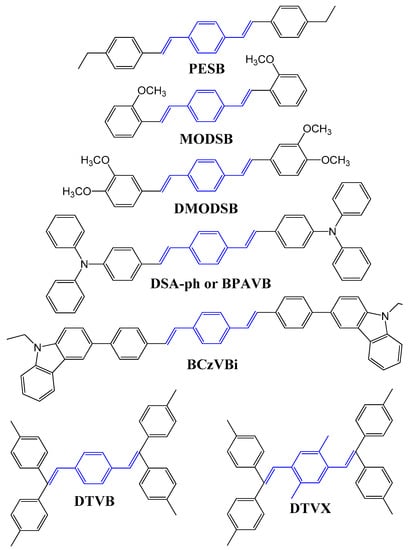
Figure 3.
Molecular structures of typical DSA derivative-based blue emitters with electron donor groups.
Later in 1993, Tokailin et al. reported a series of nonplanar DSA derivatives with different DSA cores (Figure 4), namely, DTVB and DTVX, and different alkyl group substituents at the end of the molecule, namely, DPVBi, DTVBi, and DTBPVBi, as blue emitters. They also investigated the electroluminescence characteristics of these emitters in a multi-layer OLED device (ITO as anode; TDP as HTL; DPVBi or DTVBi or DTBPVBi as EML; Alq as ETL; Mg:Ag as cathode). The OLED device fabricated with a DPVBi emitter exhibited, at 1000 cd/m2, a power efficacy of 0.6 lm/W and maximum luminance of 2280 cd/m2, with blue emission peaking at 475 nm. The EL spectra did not exhibit any emission in the longer wavelength region, supporting that both DPVBi and DTVBi had entirely avoided the formation of exciplex or charge transfer complexes [10][127].

Figure 4.
Molecular structures of non-planar (
a
) DSA diphenyl and (
b
) IDB phenyl, diphenyl, and triphenyl derivative-based blue emitters.
High device efficiencies and long operation lifetimes were realized in 1995 by doping a fluorescent styrylamine-based guest, BCzVB, into a DSA derivative, DPVBi, host material. Hosokawa et al., in 1995, utilized a DDPVBi as a blue host material and styrylamine (known as BCzVB) as a dopant [9][126]. Further improvement of this system was later published, in which the current efficacy reached 10.2 cd/A at 1.89 mA/cm2 with 1931 CIE coordinates of (0.17, 0.33) and a half-life of 20,000 h at an initial brightness (Lo) of 100 cd/m2. When oligoamine was used as a hole-injection layer for this device, the operational lifetime was further improved to 10,000 h with Lo = 500 cd/m2 [11][84]. It appears that the sky-blue emission was specifically designed by Idemitsu Kosan for the application of color-changing media (CCM) technology for full-color organic EL devices [12][128].
For a 3 wt% DSA-ph emitter doped with a 2-methyl-9,10-di(2-napthyl)anthracene (MADN) host, the device exhibited a half-decay lifetime of 46,000 h (LT50) at an initial brightness of 100 cd/m2. The resultant OLED also showed a much higher power efficacy of 5.5 lm/W and a current efficacy of 9.7 cd/A at 20 mA/cm2 with a sky-blue emission (0.16, 0.32) [11][84].
In 2007, Ho et al. reported a new series of emitters based on a seven-membered N-hetero-cyclic core structure of iminodibenzyl-distyrylarylene (IDB). In the distyrylarylene structure, a replacement of the amino group by an iminodibenzyl group improved the thermal properties (Tg varying between 119 and 137 °C) and slightly blue-shifted the emission with increasing phenyl units. The emission wavelength for DSA-ph is 458 nm, while it was 449, 447, and 443 nm for IDB-ph, IDB-diph, and IDB-triph, respectively [13][129].
In 2018, Wanshu Li et al. reported a wet-processed simple structure and high efficiency OLED using a DSA-Ph emitter doped in an MADN host.
1.2. Pyrenes
In the last fifteen years, numerous pyrene derivatives and hybrid-based blue-emitters were investigated in OLED devices due to their rigid planar structure [14][15][130,131], high thermal stability [16][17][18][70,132,133], high fluorescence quantum yield [19][20][21][22][23][134,135,136,137,138], long fluorescent lifetime [24][25][139,140], and effective carrier mobility [26][27][141,142].
However, the utilization of pyrene-based blue emitters was limited, owing to their strong tendency to form excimers and π-aggregates, which would cause red shifts and quenching of fluorescence, resulting in a lower solid-state PL quantum yield and quantum efficiency. Numerous efforts in the structural alteration of pyrene-based compounds have hence been made to enhance the PL quantum yield and diminish the aggregation characteristics.
In recent years, pyrene derivatives were extensively employed in efficient blue OLEDs, including polypyrenes [19][28][29][134,143,144], dipyrenylbenzene [30][145], alkynylpyrene [31][32][146,147], pyrene-functionalized calix[4]arenes [33][148], aryl-functionalized pyrenes [21][34][35][36][37][116,136,149,150,151], as well as oligothiophenes with pyrenyl side groups [38][152], pyrene-carbazole [17][20][31][39][40][132,135,146,153,154], pyrene-fluorene [41][42][43][44][45][46][47][48][49][155,156,157,158,159,160,161,162,163], pyrene-triphenylamine [27][50][51][142,164,165], and pyrene-anthracene [52][166] hybrids, due to their good emissive characteristics and hole mobility.
In 2011, Figueira-Duarte and Müllen comprehensively reviewed the synthesis techniques for numerous types of small molecular pyrene, oligo-pyrene, pyrene-dendrimer, and polypyrenes. They also reviewed the thermal, electrochemical, photophysical, and optical characteristics of all pyrene-based emitters and their electroluminescence characteristics in OLED devices [53][167].
In this part, the pyrene derivatives that were reported in the past few years. The Sonogashira, Sonogashira-Hogihara, Suzuki, Suzuki-Miyaura, Heck, and Yamamoto-coupling reactions have been extensively used to synthesize pyrene hybrid derivatives. The sky-blue emitter, 1-((9,9-diethyl-9H-fluorene-2yl)ethynyl)pyrene (PA-1) (Figure 5), was synthesized by the Sonogashira method via a cross-coupling reaction of 1-bromopyrene with 9,9-diethyl-2ethynyl-9H-fluorene by using a Pd(PPh3)2Cl2/PPh3/CuI catalytic system. The PA-1 exhibited a purplish-blue emission with CIE coordinates of (0.15, 0.06), a power efficacy of 1.2 lm/W, a current efficacy of 1.9 cd/A, and EQE of 3.5% at 100 cd/m2 as a 3 wt% sky-blue emitter doped into the polarity matching the CBP host [48][162].

Figure 5.
Molecular structures of pyrene-based blue emitters.
A series of pyrenoimidazole-based emitters that possess markedly high thermal characteristics were synthesized in three simple steps. Firstly, pyrene-4,5-dione was prepared via the oxidation of pyrene in the presence of ruthenium trichloride and sodium periodate. Subsequently, the pyrene-4,5-dione was reacted with the corresponding aldehyde in the presence of ammonium acetate to form sparingly soluble pyrenoimidazoles. Finally, the alkylation reaction was either executed under phase transfer catalysis to synthesize mono-pyrenoimidazoles or by employing the potassium carbonate/dimethylformamide (K2CO3/DMF) to synthesize bis-pyrenoimidazoles. These rigid pyrenoimidazole moiety-based hybrid compounds offered a very high thermal stability with decomposition temperatures from 462 to 512 °C.
With a CBP host doped with a 3 wt% mono-pyrenoimidazole, 9-butyl-10-(pyrene-1-yl)-9H-pyreno[4,5-d]imidazole (Figure 5), the resultant multi-layer OLED device showed, at 100 cd/m2, for example, a power efficacy of 1.2 lm/W, a current efficacy of 2.4 cd/A, and an external quantum efficiency (EQE) of 2.2% with CIE coordinates of (0.15, 0.32). The resultant device also exhibited a maximum luminance of 2740 cd/m2 [54][168].
It is well established that pyrene-based emitters, either molecular or polymeric, possess a planar or partial planar molecular structure, which tends to show excimer emissions and lower quantum efficiencies, resulting in an extensive bathochromic shift in emission spectra owing to the π–π stacking of pyrene chromophore units in the solid state.
In 2012, Hu and Yamato et al. synthesized a series of pyrene-based Y-shaped blue emitters using the Suzuki cross-coupling reaction of 7-tert-butyl-1,3-dibromopyrene with p-substituted phenylboronic acids. These emitters realized a low degree of π-stacking due to the steric effect of the tert-butyl group in the pyrene ring at the 7-position [19][55][134,169].
In the search for new light-emitting compounds, Promarak et al. synthesized a series of solution-processable pyrene-functionalized carbazole derivatives, N-dodecyl-3,6-di(pyren-1-yl)carbazole (CP2), N-dodecyl-1,3,6-tri(pyren-1-yl)carbazole (CP3) and N-dodecyl-1,3,6,8-tetra(pyren-1-yl)carbazole (CP4) (Figure 5), by using the Suzuki-coupling reaction [56][170].
These pyrene-carbazole hybrids showed a glass-transition temperature and decomposition temperature ranging from 70 to 170 °C and 375 to 407 °C, respectively. Among the four pyrene-moieties containing carbazole compounds, CP4, showed the highest thermal stability (Tg = 170 °C and Td = 407 °C).
However, these materials showed an undesirable donor-acceptor (DA) behavior because the carbazole central unit acts as a donor and the pyrene functional group acts as an acceptor. It is known in the literature that the DA molecular systems tend to extend π-conjugation and generate an intramolecular charge transfer (ICT) state, inducing an unwanted bathochromic shift in the search for a deep-blue emission.
An OLED device based on non-doped CP4 showed, by thermal evaporation deposition, for example, a maximum current efficacy of 6.7 cd/A and maximum luminance of 25,000 cd/m2 with CIE coordinates of (0.14, 0.26), and 2.5 cd/A and 9700 cd/m2 with CIE coordinates of (0.21, 0.28) via spin-coating [56][170].
1.3. Anthracenes
Adachi et al. reported a 9,10-diphenyl-anthracene (DPA) emitter with a 100% photoluminescence quantum yield (PLQY) [57][59]. The other major blue-doped emitter was developed by Shi et al. at Kodak in 2002 and utilized diphenylanthracene derivative 9,10-di(2-naphthyl)anthracene (ADN) (Figure 6) as a host and 2,5,8,11-tetra(t-butyl)-perylene (TBP) as a dopant to generate a blue emission of CIE (0.15, 0.23). The blue device showed a current efficacy of around 3.5 cd/A with a half-life of 4000 h at an initial light output of 700 cd/m2 [58][171].
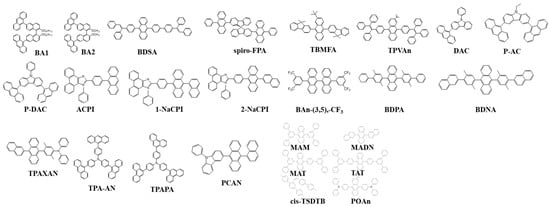
Figure 6.
Molecular structures of anthracene-based blue emitters.
In 2007, Shih et al. developed a blue-emitting material 2-tert-butyl-9,10-bis[4-(1,2,2-triphenylvinyl)phenyl]anthracene (TPVAn) (Figure 6) that contained an anthracene core and two tetraphenylethylene end-capped groups. The material possessed a high Tg of 155 °C and was morphologically stable due to the presence of the sterically congested terminal groups. A bright saturated-blue emission with CIE coordinates (0.14, 0.12) along with a 5.3% EQE crossing the theoretical limit of fluorescent materials was reported, the best performance among the non-doped blue devices [59][172].
In 2008, three materials 9,10-Bis(3′,5′-diphenylphenyl)anthracene [MAM], 9-(3′,5′-diphenylphenyl)-10-(3‴,5‴-diphenylbiphenyl-4″-yl)anthracene [MAT], and 9,10-bis(3″,5″-diphenylbiphenyl-4′-yl)anthracene [TAT] (Figure 6) were designed and emitted in the range of 439–445 nm. MAM and MAT have a Tg higher than 64 °C, while TAT has above 150 °C. The Tg for TAT is twice as high as the commonly used host material DPVBi (64 °C) and slightly higher than MADN (120 °C). The CIE coordinates were (0.15, 0.08) with an EQE of 7.2% [60][173].
In 2010, Zheng et al. reported a series of non-doped devices with three newly designed emitters, 2-tert-butyl-9,10-bis(9,9-dimethylfluorenyl) anthracene (TBMFA), 2-tert-butyl-9,10-bis[4-(2-naphthyl)phenyl] anthracene (TBDNPA), and 2-tert-butyl-9,10-bis[4-(9,9-dimethylfluorenyl)phenyl] anthracene (TBMFPA) (Figure 6), using naphthalene or 9,9-dimethylfluorene side units. Due to the anthracene unit, the resultant devices showed a deep-blue emission. These materials also showed a high Tg ≥ 133 °C, due to the presence of sterically congested terminal groups. The TBDNPA-based device outperformed the others by showing a low turn-on voltage of 3.0 V with an initial brightness of 1 cd/m2. The device displayed an EQE of 5.2% at 8.4 mA/cm2 with CIEy < 0.1 [61][174].
In 2011, Kim et al. synthesized four molecules displaying blue emission using anthracene moieties. The material, 3-(anthracen-9-yl)-9-ethyl-9H-carbazole (AC), 3,6-di(anthracen-9-yl)-9-ethyl-9H-carbazole (DAC), 3-(anthracen-9-yl-)-9-phenyl-9H-carbazole (P-AC), and 3,6-di(anthracen-9-yl)-9-phenyl-9H-carbazole (P-DAC) (Figure 6), was also comprised of covalent carbazole units. Among these, the undoped device with P-DAC showed a near deep-blue emission at (0.16, 0.13) with a luminance efficacy of 3.1 cd/A and EQE of 2.8%. Moreover, P-DAC as a host material doped with a BDAVBi emitter displayed a 7.7 cd/A CE and 4.7% EQE with CIE coordinates of (0.15, 0.21) at 100 mA/cm2. A negligible efficiency roll-off is observed over a broad range of current density [62][175].
In 2012, Zhuang et al. reported a series of non-doped devices using emitters 2-(4-(anthracen-9-yl)phenyl)-1-phenyl-1H-phenanthro[9,10-d]imidazole (ACPI), 2-(4-(10-(naphthalen-1-yl)anthracen-9-yl)phenyl)-1-p-henyl-1H-phenanthro[9,10-d]imidazole (1-NaCPI), and 2-(4-(10-(naphthalen-2-yl)anthracen-9-yl)phenyl)-1-phenyl-1H-phenanthro[9,10-d]imidazole (2-NaCPI) (Figure 6). The materials possess good film-forming capability and a high Td (290–354 °C). Among them, ACPI displayed the highest CEmax, at 1.6 cd/A at a low turn-on voltage of 3.0 V corresponding to CIExy (0.16, 0.17). A negligible efficiency roll-off is observed at high current densities [63][176].
In 2019, a material (4-(diphenylamino)phenyl)anthracen-9-yl)pyren-1-yl)-N,N-diphenylaniline (p-TPA-AP-TPA) (Figure 6) was synthesized with a dual-core moiety of anthracene and pyrene with a triphenylamine (TPA) side group attached at a para position to control the emission in the blue region. Moreover, the bulky molecule yielded a twisted molecular structure that prevents intermolecular interactions. The PL emission was around 473 nm in the film with a high Tg of 194 °C. The device showed a low turn-on of 3.1 V with an EQE of 8.4% and a maximum luminance of 7100 cd/m2 at CIE of (0.14, 0.15) [64][177].
1.4. Fluorenes
Fluorenes were first reported in 2006 by Lai et al. for OLED applications. They designed oligofluorenes with a certain length to obtain a high quantum yield (ՓPL = 38–75%) for a pure-blue emission. The PL emission was observed around 400 nm. An emissive layer of 130 nm was spin-casted and displayed a peak brightness of 1300 cd/m2 at a turn-on voltage of 5.3 V with a low current density of 90 mA/cm2. The CIE coordinates of (0.15, 0.09) displayed a deep-blue emission with an EQE of 2.0% and CE of 2.1 cd/A. These hindered six-arm architectures (highly branched and dendritic structures) suppress aggregation and self-quenching while the triazatruxene core facilitates charge injection, transport, and combination. Moreover, the powerful microwave-enhanced synthesis diminished impurities and chain defects that may result in quenching or keto-defects [65][178].
In 2007, Lai et al. reported a kinked star-shaped fluorene/triazatruxene co-oligomer (C1, C2 and C3) (Figure 7) that can effectively suppress aggregation and crystallization. The HOMO level was well matched to that of the anode’s work function that significantly improved the carrier transportation. The single-layer EL showed almost no change in color even at a higher voltage. The device displayed a low turn-on voltage of 3.3 V, EQE of 2.2%, and maximum luminance of 2400 cd/m2 [66][179].
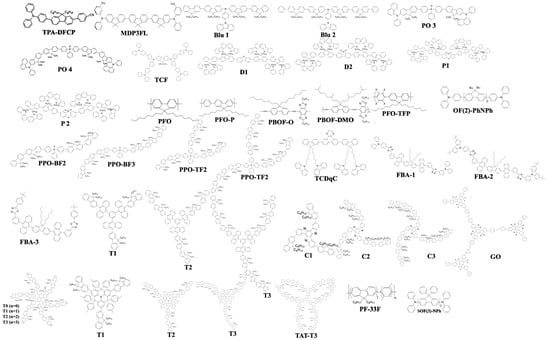
Figure 7.
Molecular structures of fluorene-based blue emitters.
In 2008, Jou et al. reported 2,7-bis{2[phenyl(m-tolyl)amino]-9,9-dimethyl-fluorene-7-yl}-9,9-dimethyl—fluorene (MDP3FL) (Figure 7) blue emitter doped in a low-polarity host, 4,4′-bis(9-carbazolyl)-biphenyl (CBP). The neat film of MDP3FL exhibits an EQE of 1.9% at 100 cd/m2 displaying a CIE of (0.15, 0.12). When doped with a 10 wt% in CBP, a 5.1% EQE was observed for a deep-blue emission at CIE (0.14, 0.08) [67][180].
In 2009, Wang et al. reported a solution-processable fluorescent π-conjugated dendrimer G0 (Figure 7). The material displayed a CEmax of 5.3 cd/A with a deep-blue emission at (0.15, 0.09). The EQEmax was 4.2% while 3.6% at 1000 cd/m2 [68][75].
Figure 7 shows the fluorene derivatives extensively utilized in efficient blue OLEDs, such as fluorene-bridged anthracene, [69][181] oligofluorenes, [70][71][72][73][74][74,77,182,183,184] p-difluorophenylene [75][185], bis(4-diphenylaminophenyl)carbazole end-capped fluorene [76][186], phosphine oxide [77][78][187,188], perfluorinated polymer [79][189], poly(3,6-Dimethoxy-9,9-dialkylsilafluorene)s [80][190], and polycyclic [81][191].
In 2020, Liu et al. reported a blue dye TPA-DFCP with a twisted D–π–A configuration where triphenylamine (TPA), benzonitrile (CP), and 9,9-dioctylfluorene served as D, A, and π-conjugation units, respectively. TPA is a strong electron donor group and has a high HOMO level. Moreover, a certain twist angle is present in the molecular space of TPA to avoid molecular accumulation. The non-doped device showed a high EQE of 7.7% with CIE coordinates of (0.15, 0.07) displaying a deep-blue emission. Meanwhile, the doped device showed an EQEmax of 8.3% and a radiative exciton utilization energy (ηr) of 58% [82][192].
1.5. Biaryl
In 2005, Fisher et al. reported two materials: N,N′-diethyl-3,3′-bicarbazyl (DEC) and 1,4,5,8-N-pentamethylcarbazole (PMC) (Figure 8). Both the materials can be used as a hole-blocking layer and blue emitter. The device based on a DEC emitter doped in a DPVBi host displayed an EQE of 3.3%, CE of 4.7 cd/A, and PE of 1.3 lm/W at CIE coordinates of (0.15, 0.10) [83][193].

Figure 8.
Molecular structures of biaryl-based blue emitters.
In 2006, Tseng demonstrated a device based on a 7,8,10-triphenylfluoranthene (TPF) emitter doped in a dipyrenylfluorene (DPF) host. With a 6 wt% of the TPF dopant, the device displayed a 3.3 lm/W PE and a 2.5% EQE at CIE coordinates of (0.16, 0.18) [84][194].
In 2007, Jou et al. reported three emitting materials, namely, trans-1,2-bis(6-(N,N-di-p-tolylamino)-naphthalene-2-yl)ethene (BNE), 2-(N,N-diphenylamino)-6-[4-(N,N-diphenylamino)styryl]naphthalene (DPASN), and di(triphenyl-amine)-1,4-divinylnaphthalene (DPVP) (Figure 8). Among them, BNE displayed the highest EQE, at 6.0%, and a PE of 12.5 lm/W at a low turn-on voltage of 3 V for a pan-blue emission at (0.19, 0.31) [85][195].
1.6. Spiro-Shaped
In 2010, Jeon et al. reported a series of spiro-based emitters, namely, N,N,N′,N′-tetraphenylspiro[fluorene-7,9′-benzofluorene] (SFBF)-5,9-diamine (BD-6DPA), N,N′-di-(2-naphthyl)-N,N′-diphenyl-SFBF-5,9-diamine (BD-6NPA), N,N′-diphenyl-N,N′-di-m-tolyl-SFBF-5,9-diamine (BD-6MDPA), and N,N′-diphenyl-N,N′-bis(4-(trimethylsilyl)phenyl)-SFBF-5,9-diamine (BD-6TMSA) (Figure 9), synthesized using an animation reaction. Among them, BD-6MDPA displayed the highest CE, at 9.1 cd/A at 6.5 V, and an EQE of 8.2% with coordinates of (0.13, 0.15). The device showed a full width at half maxima of 48 nm and an emission peaking at 463 nm [86][82].

Figure 9.
Molecular structures of spiro-based blue emitters.
In 2013, Hou’s group designed and synthesized a series of fluorinated 9,9′-spirobifluorene derivatives (SFs). The photophysical properties, energy levels, and thermal properties can be tuned using different substitutional groups of electron-withdrawing moieties, such as F and CF3. Among the series, a 2,2′,7,7′-tetrakis(3-fluorophenyl)spiro-9,9′-bifluorene (Spiro-(3)-F) (Figure 9) blue emitter displayed the best result in a non-doped stage with an emission at CIE (0.16, 0.12) peaking at 408 nm. These SFs also served as a host for blue-emitting dopants, especially Spiro-(3)-F, with a low turn-on voltage of 3.4 V showing a CE of 6.7 cd/A and an EQE of 5.0% [87][196].
1.7. Silanes
In 2001, Yu et al. reported for the first time a silane group as a blue emitter, tris(2,3-methyl-8-hydroxyquinoline) aluminum (III) (Alm23q3). The presence of two electron-donating methyl groups widened the HOMO/LUMO gap and blue-shifted the EL peaks to 470 nm. The resultant device showed a power efficacy of 0.6 lm/W at 300 cd/m2 [88][197].
In 2002, Chan et al. reported a molecular glass material (4-(5-(4-(diphenylamino)phenyl)-2-oxadiazolyl)phenyl)triphenylsilane (Ph3Si(PhTPAOXD)) (Figure 10) as a blue emitter. The material possessed a Tg of 85 °C, making it less vulnerable to heat and hence more stable. The device showed a maximum luminance of 19,000 cd/m2 with an EQE of 2.4% at CIE coordinates of (0.16, 0.18) [89][198].

Figure 10.
Molecular structures of silane-based blue emitters.
In 2015, Liu et al. reported an organosilane compound, bis(4-(1-phenylphenanthro[9,10-d]imidazol-2-yl)phenyl)diphenylsilane (Si(PPI)2) (Figure 10), as a bipolar host. The incorporation of one tetraphenylsilane and two PPI groups made the compound thermally stable with a high Td of 528 °C and a Tg of 178 °C. Moreover, when doped with a 10 wt% An(PPI)2 emitter, the device showed a PE of 8.0 lm/W and an EQE of 6.1% at CIExy (0.18, 0.17) [90][199].
1.8. Carbazole
In 2018, Jou et al. reported a carbazole-based deep-blue fluorescent emitter, 6-((9,9-dibutyl-7-((7-cyano-9-(2-ethylhexyl)-9H-carbazol-2-yl)ethynyl)-9H-fluoren-2-yl)ethynyl)-9-(2-ethylhexyl)-9H-carbazole-2-carbonitrile (JV55) (Figure 11), that showed a maximum EQE of 6.5% at CIE coordinates of (0.16, 0.06). The deep-blue emission realized a 101% color saturation according to the NTSC standard. The very high PLQY of 91%, effective host-guest energy transfer, efficient triplet energy utilization, and low doping concentration realized a low roll-off [91][200].

Figure 11.
Molecular structures of carbazole-based blue emitters.
In 2020, Yang et al. reported a blue fluorescent material with a twisted A–π–D–π–A configuration, namely, CzPA-F-PD (Figure 11). This material exhibited dual fluorescent properties that emitted blue and red emissions under PL and EL processes when triggered by trifluoroacetic acid (TFA). The property had been reversed to its initial state on neutralizing TFA with triethylamine (TEA). It was observed that hydrogen protonation of TFA amplified the lone pair electrons around the nitrogen atoms in pyridine, enhancing the electron acceptor ability. This scheme also played a significant role during the dual fluorescent process. The material possessed a good exciton utilization efficiency of 67%, exceeding the upper limit of spin-statics for fluorescent materials [92][201].
1.9. Oxidiazole
In 2018, Wu et al. reported that triazine, oxadiazole, triazole, cyno-substituted benzene, and benzothiadiazole worked as acceptor units while carbazole, arylamine, phenothiazine, and their derivatives were utilized as donor moieties for a bipolar structure. Consequently, they utilized phenothiazine and 9,9-diphenyl-9,10-dihydroacridine as a donor unit and oxadiazole derivatives, 2,5-bis(4-bromophenyl)-1,3,4-oxadiazole and 2-(4-bromophenyl)-5-phenyl-1,3,4-oxadiazole, as acceptor units to synthesize a series of bipolar emitters, namely, 2DPAc-OXD, DPAc-OXD, 2PTZ-OXD, and PTZ-OXD (Figure 12). All the materials possessed a high decomposition temperature above 358 °C, with emissions in the PL range of 435–512 nm. For OLED applications, these materials showed a moderate turn-on voltage of around 4.2 V along with a highest EQE of 4.0% when using the material 2PTZ-OXD [93][202].
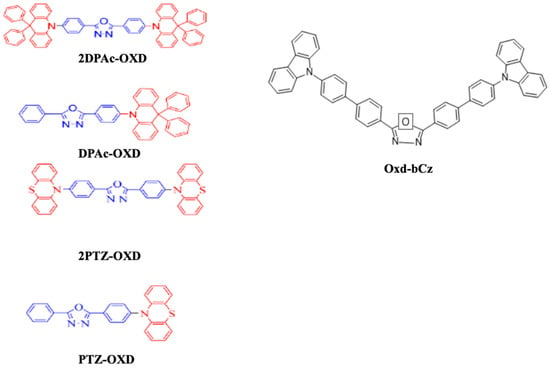
Figure 12.
Molecular structures of oxadiazole-based blue emitters.
Later that year, Wang et al. reported a bipolar molecule, bis(4’-(9H-carbazol-9-yl)-[1,1-biphenyl]-4-yl)-1, 3, 4-oxadiazole (Oxd-bCz) (Figure 12), by incorporating electron-donor and electron-withdrawal moieties. The material emitted a purple-blue fluorescence at 431 nm when diluted in dichloromethane. From a device perspective, the device turned on at 3.6 V and displayed a maximum EQE of 5.6% at CIEy ~ 0.07 [94][203].
2. Phosphorescent Type
Developing phosphorescent emitters is essential as they have the potential to realize a high-efficiency OLED. In 1998, Forrest and Thompson et al. discovered a phosphorescent emitter to develop a nearly 100% internal quantum efficiency because of their ability to efficiently harvest both singlet and triplet excitons [95][96][97][98][99][204,205,206,207,208]. Since then, very high-efficiency phosphorescent green and red emitters have emerged. However, it was a great challenge to synthesize a highly energy-efficient phosphorescent blue emitter that exhibits a long lifetime with high color purity. Deep blue emitters should have a high triplet energy (~3 eV), a high photoluminance quantum yield (PLQY), and a short excited-state lifetime. To realize the above-mentioned features, considerable efforts have been made to develop a high performance deep-blue emitter.
On the basis of previous investigations, it is well established that complexes of heavy metals such as iridium (III), platinum (II), and ruthenium (II) have been utilized to synthesize promising blue emitters [100][101][102][209,210,211]. Among them, iridium complex-based phosphors have shown enormous potential to realize high-efficiency blue OLEDs. Moreover, to achieve a deep-blue emission, thermally and electrochemically stable fluorine-free cyclometalating ligands [101][103][104][210,212,213] were introduced either by using electron-withdrawing groups [105][106][214,215] or electron-deficient heterocycles [106][107][215,216]. Furthermore, to stabilize HOMO, ancillary ligands with strong ligand field strength, such as isocyanide or phosphine, were utilized [106][108][215,217].
2.1. Iridium (III) Complexes
In 2001, Adachi et al. reported a sky-blue phosphorescent emitter, FIrpic (Figure 13), with an EQE of 5.7% and CIE coordinates of (0.16, 0.29) [109][60]. In 2003, Holmes et al. synthesized a blue emitter, iridium(III) bis(2,4-difluorophenylpyridinato)tetrakis(1-pyrazolyl)borate (FIr6) (Figure 13), with an EQE of 12% at (0.16, 0.26) [110][218]. In the same year, Bazan’s group reported a series of anthracene-containing binaphthol emitters with CIE coordinates of (0.18, 0.21) without revealing device performance [100][209].
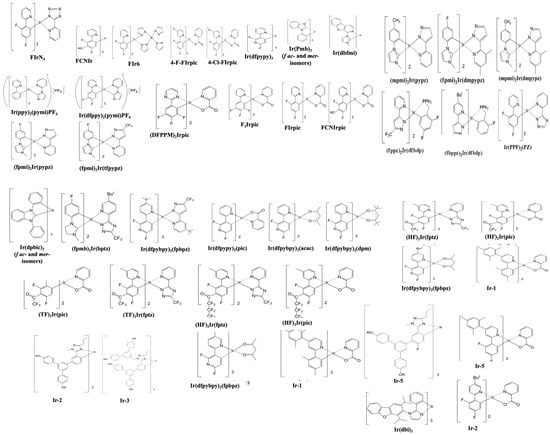
Figure 13.
Molecular structures of Ir-complex-based blue emitters.
In 2005, Holmes reported fac- and mer-isomers of fluorine-free emitters tris(phenyl-methyl-benzimidazole)iridium(III) (f-Ir(pmb)3) and (m-Ir(pmb)3), respectively (Figure 13). When f-Ir(pmb)3 was doped into a p-bis(triphenylsilyly)benzene (UGH2) host, the device showed an EQE of 5.8% for a deep-blue emission with CIE coordinates of (0.17, 0.06) [101][210].
Moreover, other fluorine-free Ir complexes which resulted in a blue emission were also reported. They were mer-tris(Ndibenzofuranyl-N-methylimidazole) iridium(III) [Ir-(dbfmi)] (Figure 13) [103][212] and tris(1-cyanophenyl-3-methylimidazolin-2-ylidene-C,C2′) iridium(III) [Ir(cnpmic)] [104][213].
In 2009, Kang et al. introduced a blue emitter based on an iridium(III) complex of 2′,6′-difluoro-2,3′-bipyridine (fac-Ir(dfpypy)3) (Figure 13) with CIE coordinates of (0.14, 0.12) [111][219]. Meanwhile, the same group reported a comparatively more efficient device with an EQE of 10% at 1000 cd/m2 at (0.15, 0.24) by employing its modified complex, (dfpypy)2Ir(μ-Cl)2) [112][220].
In 2010, Kido et al. reported a halogen-free blue emitter, mer-tris(N-dibenzofuranyl-N′-methylimidazole)iridium(III) (Ir(dbfmi)) (Figure 13). By doping a 10 wt% Ir(dbfmi) into a 3,6-bis(diphenylphosphoryl)-9-phenylcarbazole (PO9) host, the resultant device showed a maximum EQE of 19% with CIExy (0.15, 0.19) [103][212]. In 2011, Hsieh et al. reported blue emitters of iridium bis(carbene) complexes, namely, Ir(mpmi)2(pypz), Ir(fpmi)2-(pypz), and Ir(fpmi)2(tfpypz) (Figure 13), that showed an EQE of 15, 14, and 7.6% and CIExy of (0.14, 0.27), (0.14, 0.18), and (0.14, 0.10), respectively [113][221].
In 2012, Fan et al. reported two phosphoryl/sulfonyl-substituted iridium complexes, POFIrpic and SOFIrpic (Figure 13), by introducing phosphoyl/sulfonyl moieties into the 5′-position of a phenyl ring in the structural frame of FIrpic. By doping a POFIrpic emitter into PVK:OXD-7 hosts, the solution-processable blue device showed CIE coordinates of (0.16, 0.29) and an EQE of 3.5% at 1000 cd/m2 [114][222]. In 2013, Fan et al. modified the FIrpic by introducing fluorine, chlorine, and bromine atoms to the 4-position of a pyridine ring. The 4-F-FIrpic-based device showed an EQE of 15% for a blue emission with CIExy (0.15, 0.28) [115][223]. Meanwhile, Kessler et al. synthesized a heteroleptic iridium complex based on a 4-(tert-butyl)-2′,6′-difluoro-2,3′-bipyridine ligand (FK306) (Figure 13) that showed an EQE of 13% at 1000 cd/m2 for a greenish-blue emission at (0.16, 0.25) [116][224]. In the same year, Yoon et al. reported a series of Ir(III) complexes using (4′-substituted-2′-pyridyl)-1,2,4-triazole ancillary ligands. By doping a 10 wt% of iridium complex of 5-(4′-methylpyridine-2′-yl)-3-trifluoromethyl-1,2,4-triazolate ancillary ligand (Ir5) (Figure 13) into a 4,4′-bis(9-carbazolyl)-2,2′-dimethylbiphenyl (CDBP) host, the resultant device showed a blue emission with CIE coordinates of (0.15, 0.18) [117][225].
Moreover, Lee et al. reported a series of near deep-blue iridium(III) complexes, (TF)2Ir(pic), (TF)2Ir(fptz), (HF)2Ir(pic), and (HF)2Ir(fptz) (Figure 13). They consisted of 2′,4″-difluororphenyl-3-methylpyridine with a trifluoromethyl carbonyl or heptafluoropropyl carbonyl group as the main ligand and a picolinate or a trifluoromethylated triazole as the ancillary ligand. Among them, (TF)2Ir(fptz) achieved an EQE of 7.4% at 100 cd/m2 for a blue emission with CIE coordinates of (0.14, 0.11) [118][226].
In 2014, Liu et al. reported a host molecule, 3,6-bis(diphenylphosphoryl)-9-(4′-(diphenylphosphoryl) phenyl)-carbazole (TPCz) (Figure 13). The solvent effect was studied by dissolving a mixture of TPCz and FIrpic (emitter) in various polar solvents. They thought that the higher polar halogen-free solvent isopropanol provided good solubility, helping resist the aggregation of FIrpic and hence render a more densely packed emissive layer. The efficiencies of 22 cd/A and 16 lm/W at (0.15, 0.32) were also reported [119][227].
In 2015, Sun et al. reported a series of 3,3′-bicarbazole (mCP)-functionalized tetraphenylsilane derivatives (SimCPx) (Figure 13). On changing the number of mCP subunits on the central Si atom, four molecules, namely, bis(3,5-di(9H-carbazol-9-yl)phenyl)diphenylsilane (SimCP2), tris(3,5-di(9H-carbazol-9-yl)phenyl)methylsilane (SimCP3-CH3), tris(3,5-di(9H-carbazol-9-yl)phenyl)phenylsilane (SimCP3-Ph), and tetrakis(3,5-di(9H-carbazol-9-yl)phenyl)silane (SimCP4), were synthesized as bipolar hosts. The derivatives possessed a wide bandgap and good solubility. Moreover, a high thermal and morphological stability was beneficial for the formation of amorphous and homogeneous film via wet processing. Among them, SimCP4 showed the best electron-transporting ability and hence, at a low driving voltage of 4.8 eV, achieved an EQEmax of 14%, CEmax of 28 cd/A, and PEmax of 14 lm/W corresponding to a CIExy (0.15, 0.35) by using a FIrpic emitter [120][228].
In 2016, Byeong et al. reported meta-linked diphenylether-based materials, 9-(3-(3-(9H-carbazol-9-yl)phenoxy)phenyl)-9H-pyrido[2,3-b]indole (CzDPEPI) and 9,90-(oxybis(3,1-phenylene))bis(9H-carbazole) (CzDPECz) (Figure 33). The presence of a pyridoindole moiety assisted in getting a better electron injection and hence a lower driving voltage. The CzDPEPI host possessed a high triplet energy and therefore was suitable for an Ir complex (Ir(dbi)3) emitter. The resultant device showed an EQEmax of 24% and PEmax of 39 lm/W at CIExy (0.19, 0.37) [121][229].
In 2017, Park et al. reported a series of bipolar host materials, namely, N-(3-(9H-carbazol-9-yl)phenyl)-N-(pyridin-2-yl)pyridin-2-amine (mCPPy), 5-(9H-carbazol-9-yl)-N1,N1,N3,N3-tetra(pyridin2-yl)benzene-1,3-diamine (CPDPy), and N-(3,5-di(9H-carbazol-9-yl)phenyl)-N-(pyridin2-yl)pyridin-2-amine (DCPPy) (Figure 13). The materials possessed a high bandgap (>3.5 eV) and a high triplet energy (>2.9 eV). The device composing CPDPy doped with FIrpic (emitter) showed a highest EQEmax of 22% and PEmax of 24 lm/W at CIE coordinates of (0.16, 0.31) [122][230].
In 2018, Kim et al. reported an emitter material, fac-tris(2,3-dimethylimidazo[1,2-f]phenanthridinato-k2C,N)iridium(III) (Figure 13), that had a facial (fac) geometry around the iridium atom. A multilayered device composed of 1,3-bis(N-carbazolyl)benzene as a host/hole-transporting layer with a 5 wt% emitter displayed a high EQEmax of 20% and PEmax of 32 lm/W with coordinates of (0.18, 0.34) [123][89].
In 2020, Yuan et al. reported a host material, 9,9-bis(9-phenyl-9H-carbazol-3-yl)-9H-thioxanthene,10,10-dioxide (BPhCz-ThX) (Figure 13), based on an insulating C(sp3) bridge-linked thioxanthone via a facile Friedel–Crafts-type substitution reaction. The material possessed a high thermal stability, good film-forming ability, a high triplet energy (3.05 eV), and a total yield of 63%. On using a FIrpic emitter, the device showed an EQEmax of 9.6%, CEmax of 21 cd/A, and PEmax of 8.5 lm/W at (0.19, 0.36) [124][231].
2.2. Platinum Complexes
Platinum (Pt) complexes are the second most appreciated organic dopants to realize a highly efficient deep-blue emitter. Pt-based phosphors appear to have the highest potential for EL applications due to their higher triplet quantum yield, relatively short triplet state lifetime, and tunable emission color [102][104][125][211,213,232]. Based on their structural features, these phosphors are classified into three main categories: (i) tetradentate ligands, (ii) tridentate ligands, and (iii) bidentate ligands.
In 2008, Yang et al. reported a blue device by utilizing a platinum(II) 1,3-difluoro-4,6-di(2-pyridinyl)benzene chloride (Pt-4) (Figure 14) emitter, and the resultant device exhibited CIE coordinates of (0.15, 0.26) with a maximum EQE of 16% [102][211].

Figure 14.
Molecular structure of platinum complex-based blue emitters.
In 2013, Turner et al. synthesized emitters based on cyclometalated tetradentate platinum complexes, a blue PtOO1, and a blue-green PtOO2 emitter (Figure 14). The device using PtOO2 exhibited an EQE of 8.7% with CIE coordinates of (0.21, 0.38) at 1000 cd/m2 [125][232]. In the same year, Hang et al. reported Pt complexes with tetradentate ligands. These complexes have a conventional cyclometalated fragment bridged with oxygen to an ancillary chelate, such as phenoxyl pyridine (POPy) or carbazolyl pyridine (CbPy). Doping 6 wt% emitters, Pt[pmi-O-POPy] (PtOO7), Pt[pmi-O-CbPy] (PtON7) and Pt[ppz-O-CbPy] (PtON1), into a 2,6-bis(N-carbazolyl)pyridine (26mCPy) host resulted in CIE coordinates of (0.15, 0.10), (0.15, 0.14), and (0.15, 0.13) and an EQE of 0.5, 15, and 21%, respectively, at 1000 cd/m2 [104][213].
In 2015, Liao et al. reported a series of Pt(II) metal complexes [Pt(Ln)], n = 1–5 based on tetradentate bis(pyridyl azolate) chelates. Among them, L5 (Figure 14) showed a high EQEmax of 15%, CEmax of 36 cd/A, and PEmax of 38 lm/W at CIE coordinates of (0.19, 0.34) [126][233].
In 2019, Klimes et al. reported a step-wise graded doping of platinum(II) 9-(pyridin-2-yl)-2-(9-(pyridin-2-yl)-9H-carbazol-2-yloxy)-9H-carbazole (PtNON) (Figure 14). The emissive layer was composed of a 20% PtNON:mCBP (10 nm)/10% PtNON:mCBP (4 nm)/2% TBPe:mCBP (2 nm)/10% PtNON:mCBP (4 nm)/6% PtNON:mCBP (10 nm). Consequently, the device showed an EQEmax of 18% and a lifetime of 709 h [LT70] at 1000 cd/m2 with CIExy (0.16, 0.28) [127][102].
2.3. Other Metal Complexes
Due to limited availability and high cost, some research efforts have been made to substitute heavy metal complexes with comparatively low-cost metals such as zinc (Zn), copper (Cu), etc. In 2004, Wang et al. synthesized a Zn(II) metal complex-based phosphorescent blue emitter using 4,4′-diphenyl-6,6′-dimethyl-2,2′-bipyrimidine ligands, [(Zn(pmbp)2(ClO4)2 and Zn(pmbp)Cl2]. However, no efficiencies or color coordinates were reported [128][234].
In 2008, Xu et al. reported a deep-blue emitting Zn(II) complex, Zn(Lc)2 (Lc− = 2-(1-(6-(9H-carbazol-9-yl)hexyl)-1H-benzo[d]imidazol-2-yl)phenolate) (Figure 15), based on a carbazole-functionalized N^O ligand. The material possessed a Td of 427 °C and an emission peak at 422 nm [129][235]. In 2013, Lee et al. synthesized two Zn complexes, bis(2-(oxazol-2-yl)phenolate)zinc (ZnOx2) and bis(2-(1-methyl-1h-imidazole-2-yl)phenolate)zinc (ZnIm2) host materials. The blue device based on a 3 wt% FIrpic (emitter) doped in ZnIm2 reached an EQE of 20% at 100 cd/m2 and 18% at 1000 nits [130][236].

Figure 15.
Molecular structure of Zn(Lc)2 blue emitter.
Suitable host materials were presented to aid the emission of phosphorescent-based blue emitters as reported by Chaskar et al [131][1] and Yook et al [132][237].
3. Thermally Activated Delayed Fluorescence (TADF) Type
High price and rare availability of heavy metals have limited the low-cost and long-term mass production of phosphorescent blue emitters. To resolve these problems, the search for a highly efficient deep-blue fluorescent emitter is still a subject of current interest, as they have a greatest possibility of a longer operational lifetime and a deep-blue emission at low cost with highly sustainable purely organic luminescent molecules [133][238].
In 2009, Adachi et al. designed and synthesized the first heavy metal-free TADF emitter [134][239]. Since then, numerous efforts have been made to realize efficient TADF-based blue emitters, especially with a smaller singlet-triplet energy difference (Δ𝐸𝑆𝑇) [134][135][136][137][138][139][140][239,240,241,242,243,244,245]. Presently, aromatic- and metal (such as Li, Al, Mg, Cu, and Zn)-based blue emitters have been found useful in achieving a small Δ𝐸𝑆𝑇.
3.1. Aromatic-based
Over the past few years, researchers have extensively designed and synthesized aromatic-based efficient TADF emitters by using abundant elements, such as carbon, hydrogen, oxygen, nitrogen, sulphur, etc. So far, a few molecular design strategies have been reported to achieve smaller Δ𝐸𝑆𝑇(<0.1 eV) values with a high PLQY (~100%). Most importantly, the delocalization of frontier molecular orbitals (highest occupied molecular orbital (HOMO) and lowest unoccupied molecular orbital (LUMO) energy levels) in a donor–acceptor (D–A) type TADF emitter with a well-separated HOMO and LUMO levels can effectively realize a smaller Δ𝐸𝑆𝑇and a nearly 100% PLQY [141][246]. Moreover, increasing a steric hindrance between D–A units can also lead to the spatial separation of the frontier molecular orbitals.
In aromatic-based TADF emitters, the spatial overlap between the frontier molecular orbitals can be successfully controlled by choosing a suitable D–A pair. Moreover, it has been found that the donor–acceptor–donor (D–A–D) type emitters are more effective than those of the D–A type in achieving a higher PLQY and a strong spatial separation of HOMO LUMO levels [142][143][65,247]. Since 2009, several D–A- and D–A–D-type bipolar emitters have been reported. Among them, a few emitters demonstrated a nearly 100% internal quantum efficiency (IQE) and a 20% EQE in blue devices [141][144][145][246,248,249].
On the basis of D–A pairs, aromatic-based TADF blue emitters can be classified into seven sub-categories (Figure 16), which comprise diphenylamine, acridine, carbazole, and phenoxazines as electron-donor units and diphenylsulfone, thioxanthone, benzophenone, triazine, oxadiazole, triazole, and phthalonitrile as electron-acceptor units (Figure 17).

Figure 16. Types of aromatic TADF blue emitters based on different donor–acceptor pairs. All abbreviations are given as follows: PA (phenylamine), DPS (diphenylsulfone), ACR (acridine), Cz (carbazole), PN (phthalonitrile), PXB (phenoxaborin), PXZ (phenoxazines), TAZ (triazole), and TRZ (triazine).
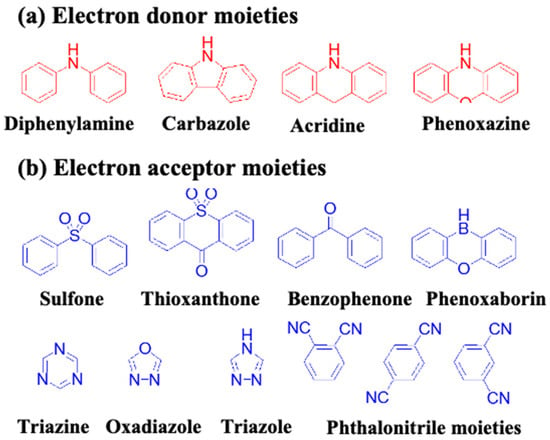
Figure 17.
Molecular structures of (
a
) electron donor moities and (
b
) electron acceptor moities, frequently used in aromatic-based blue TADF emitters.
Diphenylamine and Diphenylsulfone (DPA-DPS) Derivatives
Diphenylamine moiety-containing aromatic compounds are well-established hole-transporting materials in OLED devices. In contrast, diphenylsulfone moiety-comprising materials are well studied as electron transporting materials. These moieties have also been used to design bipolar hosts [146][147][148][149][250,251,252,253]. In accordance with the molecular design strategy, in 2012, Adachi et al. synthesized a series of bipolar TADF emitters, bis[4-(diphenylamino)phenyl] sulfone (DPA-DPS) and bis{4-[bis(4-tert-butylphenyl)amine]phenyl} sulfone (DTPA-DPS) (Figure 18), using diphenylamine donor and diphenylsulfone acceptor moieties [150][254]. The DPA-DPS and DTPA-DPS emitters possessed a ΔEST of 0.54 and 0.45 eV and a PLQY of 57 and 65%, respectively. In a doped device with a bis[2-(diphenylphosphino)phenyl]ether oxide (DPEPO) host, the DPA-DPS-based device exhibited an EQEmax of 2.9%, while the DTPA-DPS-based device showed an almost double EQEmax of 5.9%. The higher EQE of the DTPA-DPS emitter is attributed to a low ΔEST, which possessed an effective triplet to singlet-exciton upconversion.

Figure 18.
Molecular structures of DPA-DPS-based blue emitters.
Acridine and Diphenylsulfone (ACR-DPS) Derivatives
Acridine derivatives were utilized as hole-transporting and bipolar host materials in OLEDs [151][152][153][154][155][156][157][158][255,256,257,258,259,260,261,262]. Combinations of acridine-based electron-donor and diphenylsulfone-based electron-acceptor units have been widely studied for TADF type emitters. In 2014, Adachi’s group designed and synthesized an acridine donor and diphenylsulfone acceptor moiety-based 9,9-(dimethyl-9,10-dihydroacridin)diphenyl sulfone (DMAC-DPS) (Figure 19) emitter. The emitter possessed a ΔEST of 0.08 eV with an 80% PLQY and a 1.7 to 3 μs TADF decay time. By doping into a DPEPO host, the DMAC-DPS-based device exhibited an EQEmax of 20% for a greenish-blue emission at (0.16, 0.20). The resultant device performance was almost independent of the emitter doping concentration [144][248]. Moreover, the same group reported an EQEmax of 20% for a sky-blue emission with (0.16, 0.29) by using a non-doped DMAC-DPS emitter [145][249].

Figure 19.
Molecular structures of ACR-DPS-based blue emitters.
In 2014, Nakanotani et al. achieved an EQEmax of 13% for a bluish-green emission with coordinates (0.17, 0.30) by using a 1 wt% fluorescent emitter, 2,5,8,11-tetra-tert-butylperylene, along with a 15 wt% of TADF emitter, 10-phenyl-10H, 10′H-spiro[acridine-9, 9′-anthracen]-10′-one (ACRSA), in a bis-(2-(diphenylphosphino)phenyl)ether oxide (DPEPO) host [159][263].
In 2017, Nakao reported three emitters, namely, Ac-46DPPM, Ac-26DPPM, and CzAc-26DPPM (Figure 39), with 2,4,6-triphenylpyrimidine as an acceptor and tri- or penta-substituted acridine as a donor unit. Among them, CzAc-26DPPM displayed an EQE of 15% and CE of 35 cd/A at 100 cd/m2 for a bluish-green emission with coordinates (0.21, 0.38) [160][264].
Carbazole and Diphenylsulfone (Cz-DPS) Derivatives
Carbazole-based polycylic aromatic hydrocarbon compounds are extensively studied in OLED devices due to their numerous superlative characteristics, such as a strong hole-transporting ability, high thermal stability, large optical band gap, high triplet energy, rational PLQY, and easy functionalization [161][162][265,266]. On the other hand, diphenyl sulfone derivatives are robust electron-transporting materials for OLED devices [150][254].
In 2012, Zhang et al. reported an EQEmax of 10% for a deep-blue emission with CIE coordinates of (0.15, 0.07) by doping a TADF blue emitter, bis[4-(3,6-di-tert-butylcarbazole)phenyl] sulfone (DTC-DPS) (Figure 20), into a DPEPO host. The resultant device realized an EQE over three times higher than that of a diphenylamine-based DPA-DPS and nearly two times higher than that of a tert-butyl diphenylamine-derivative DTPA-DPS. The DTC-DPS exhibiting a high EQE may be attributed to a relatively small ΔEST value of 0.32 eV and a high PLQY of 69% because of a considerably strong electron donating characteristic of carbazole units [150][254].
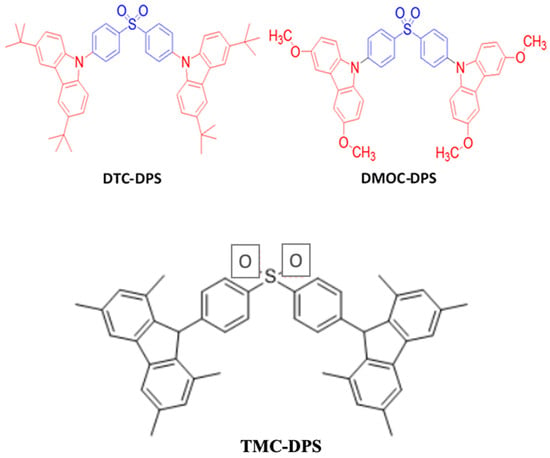
Figure 20.
Molecular structures of Cz-DPS-based blue emitters.
In order to further decrease the ΔEST value, in 2014, Wu et al. designed a blue emitter, bis [4-(3,6-dimethoxycarbazole)phenyl]sulfone (DMOC-DPS) (Figure 20), by using a methoxy substituted carbazole with an electron-acceptor sulfone. The emitter realized a ΔEST of 0.21 eV with a 93 μs TADF decay time and a 56% PLQY. In a doped blue device with a DPEPO host, the DMOC-DPS exhibited an EQEmax of 15% with (0.16, 0.16) coordinates [163][267]. The reason why the DMOC-DPS resulted in an EQE much higher than that of the DTC-DPS may be attributed to a comparatively smaller ΔEST.
Furthermore, in 2016, Lee et al. reported a TADF emitter, TMC-DPS (Figure 20), with diphenyl sulfone (DPS) as an electron acceptor and 3,6-dimethoxycarbazole (DMOC) and 1,3,6,8-Tetramethyl-9H-carbazole (TMC) as electron donor units. The material possessed a low ΔEST of 0.09 eV, much lower than that of DMOC-DPS, due to a large dihedral angle that creates a small spatial overlap between the frontier molecular orbitals [164][268].
Carbazole and Triazine (Cz-TRZ) Derivatives
Nitrogen-containing heterocyclic compounds, such as triazine and 1,3,4-triazole, have been widely used as electron-accepting units in the molecular scaffold of electron-transporting materials because of their electron-deficient nature. To design a bipolar TADF emitter, strong hole-transporting carbazole moieties have been added onto transporting triazine moieties. Both moieties are extensively utilized to design an efficient bipolar host and blue light-emitting materials.
In 2013, Serevičius et al. reported a 6% EQEmax for a greenish-blue OLED with (0.23, 0.40) by using a 9-(4,6-diphenyl-1,3,5-triazin-2-yl)-9′-phenyl-3,3′-bicarbazole (CzT) (Figure 21) emitter [165][269]. In 2014, Hirata and co-workers reported a series of bipolar blue light-emitting materials (2a, 2b, and 2c) (Figure 21) by employing indolocarbazole and triazine moieties. The resultant device employing a 2a emitter doped in a DPEPO host realized a highest EQE of 21% for a sky-blue device with (0.19, 0.35) [141][246].

Figure 21.
Molecular structures of Cz-TRZ-based blue emitters.
In 2015, Lee et al. reported a pair of bipolar TADF type blue emitters (DCzTRz and DDCzTRz) (Figure 21) with dicarbazolylbenzene donor and triazine acceptor moieties [166][270]. Both DCzTRz and DDCzTRz exhibited a ΔEST of 0.25 and 0.27 eV and a solid state PLQY of 43 and 66%, respectively. As both emitters were doped into a DPEPO host, the DCzTRz emitter-based device exhibited a maximum EQE of 18% with (0.15, 0.15), while a 19% EQE with (0.16, 0.22) was reported for the DDCzTRz-based device. Furthermore, owing to high thermal and electrical stability, the DDCzTRz-based device also demonstrated an operational lifetime (T80 = 52 h at an initial luminance of 500 cd/m2).
In 2020, Su et al. reported a 3,3′-bicarbazole/triphenyltriazine-derivative (BCz-TRZ) (Figure 21) emitter with a ΔEST of 0.37 eV by controlling the length of donor and acceptor moieties and increasing the D–A distance. The BCz-TRZ-based device exhibited a lifetime (LT50) of 495 h and an EQEmax of 20% at an emission wavelength of 486 nm [167][114].
Carbazole and Phthalonitrile (Cz-PN) Derivatives
Phthalonitrile-derivative compounds have attracted considerable attention because of their strong electron-withdrawing nature. Phthalonitrile-functionalized aromatic compounds are widely used as electron-transporting, charge-generation, and light-emitting materials in OLEDs. To achieve bipolarity in the molecular design of phthalonitrile-based aromatic compounds, such as bipolar hosts and TADF emitters, strong electron donor carbazole units are appended onto the strong electron donor phthalonitrile unit [168][169][271,272].
In 2012, Uoyama et al. designed a series of carbazole and phthalonitrile materials. Among them, 4,5-di(9H-carbazol-9-yl) phthalonitrile (CzTPN) (Figure 22) realized a sky-blue emission. The CzTPN exhibited a ΔEST of 0.29 eV with a 47% PLQY. In a doped device with a CBP host, the CzTPN emitter exhibited a maximum EQE of 8% for a sky-blue emission with an emission wavelength at 473 nm [168][271]. Furthermore, in 2013, Masui et al. achieved a maximum EQE of 13% with (0.17, 0.30) by doping the CzTPN emitter into an mCP host [170][64].

Figure 22.
Molecular structures of Cz-PN-based blue emitters.
In 2015, Lee et al. reported a maximum EQE of 16% for a blue device with (0.17, 0.19) by doping a 15 wt% 4,6-di(9H-carbazol-9-yl)isophthalonitrile (DCzIPN) (Figure 22) in a mCP host [171][273]. In the same year, Lee et al. designed and synthesized two blue emitters, 4,5-bis(benzofuro[3,2-c]carbazol-5-yl)phthalonitrile (BTCz-2CN) and 4,5-bis(benzo[4,5]thieno [3,2-c]carbazol-5-yl)phthalonitrile (BFCz-2CN) (Figure 22), by employing benzofuro- and benzothieno-functionalized carbazole units with a phthalonitrile unit. BTCz-2CN and BFCz-2CN exhibited a ΔEST value of 0.13 and 0.17 eV with a 95 and 94% PLQY, respectively. The BTCz-2CN showed a decay lifetime of 2.6 μs, which is larger than that of the BFCz-2CN counterpart (1.98 μs). The short decay time of the BTCz-2CN and BFCz-2CN may be attributed to their small ΔEST. Moreover, BTCz-2CN and BFCz-2CN also showed a high Tg of 204 and 219 °C and Td of 397 and 434 °C, respectively. In doped devices with an mCP host, the BTCz-2CN- and BFCz-2CN-based devices resulted in a maximum EQE of 12.1 and 11.8% with a similar EL emission peaking at 486 nm [172][274].
In 2020, Yi et al. reported three molecules, namely, 4CzIPN-CF3, 3CzIPN-H-CF3, and 3CzIPN-CF3 (Figure 22). They were synthesized by lowering the electron-withdrawing ability of the acceptor group or by reducing the number of carbazole donors of the base molecule, 1,2,3,5-tetrakis(carbazol-9-yl)-4,6-dicyanobenzene (4CzIPN). Among them, the 4CzIPN-CF3- and 3CzIPN-H-CF3-based devices with a SimCP:oCF3-T2T co-host system displayed a blue-shifted emission with coordinates (0.21, 0.41) and (0.16, 0.19), respectively, as compared with a 4CzIPN emission (0.22, 0.48). The devices showed an EQEmax of 23 and 17%, and 21 and 15% at 1000 nits, respectively [173][275].
Acridine and Phenoxaborin (Cz-PXB) Derivatives
In 2015, Numata et al. synthesized a series of D–A-type emitters (1-4) (Figure 23) with acridine derivatives as donor units and a 10H-phenoxaborin-type acceptor [174][276]. The resultant maximum EQE ranged from 20 to 13%, while chromaticity coordinates for a sky-blue emission ranged from (0.14, 0.23) to deep-blue (0.15, 0.08) by doping a 20 wt% of 1–4 emitters into an 8-bis(diphenylphosphine oxide) dibenzofuran (PPF) host. Moreover, the resulting sky-blue device also demonstrated a maximum EQE of 22% when the doping concentration of emitter 1 was further increased to 50 wt% in the same PPF host. The high efficiencies may be attributed to three key factors. First, the ACR-PXB series emitters possessed a higher PLQY value ranging from 56 to 100%, a shorter decay time ranging from 1.6 to 4.02 μs, and a smaller ΔEST value ranging from 0 to 0.16 eV. Second, rational bipolar characteristics of the emitters may help to achieve an effective charge carrier injection balance in the emissive layer. Third, the high triplet energy (3.21 eV)-host material restricted any backward energy transfer and facilitated an effective host-to-guest energy transfer. As reported, the device performance was greatly influenced by the ΔEST and PLQY of the emitters. The PLQY increased from 56 to 100% for emitter 1 as ΔEST decreased from 0.16 to 0 eV [174][276].

Figure 23.
Molecular structures of Cz-PXB-based blue emitters.
Phenoxazines and Triazole (PXZ-TAZ) Derivatives
Bipolar compounds based on phenoxazine electron-donor and triazole electron-acceptor moieties have been widely investigated to design the bipolar host materials for OLEDs [refs]. In 2013, Adachi et al. reported two TADF blue emitters, 10-(4-(4,5-diphenyl-4H-1,2,4-triazol-3-yl)phenyl)-10H-phenoxazine (PXZ-TAZ) and 10,10′-((4-phenyl-4H-1,2,4-triazole-3,5-diyl)bis(4,1-phenylene))-2-bis(10H-phenoxazine) (2PXZ-TAZ) (Figure 44), by using 1,2,4-triazole core-based emitters with a 10H-phenoxazine group. The PXZ-TAZ and 2PXZ-TAZ emitters exhibited a PLQY of 13 and 15% in neat films. The PLQY was greatly enhanced from 15 to 52% as a 6 wt% 2PXZ-TAZ emitter was doped into a DPEPO host. The 2PXZ-TAZ also showed a maximum EQE of 6.4% with (0.16, 0.15) and an EL emission peaking at 456 nm [142][65].

Figure 24.
Molecular structures of PXZ-TAZ-based blue emitters.
Acridine and Triazine (ACR-TRZ) Derivatives
As described in prior sections, both phenoxazine and triazine moieties have been extensively utilized to design bipolar hosts and TADF emitters for OLEDs. In 2015, Tsai et al. designed and synthesized a DMAC-TRZ (Figure 25) emitter based on 9,9-dimethyl-9,10-dihydroacridine as a donor unit and 2,4,6-triphenyl-1,3,5-triazine as an acceptor unit. The DMAC-TRZ emitter showed a ΔEST of 0.05 eV and a delay lifetime of 3.6 μs with an 83% PLQY. Furthermore, the ΔEST and the delay lifetime were decreased to 0.046 eV and 1.9 μs, respectively, while the PLQY was increased to 90% as the DMAC-TRZ emitter was doped into a 9-(3-(9H-carbazol-9-yl)phenyl)-9H-carbazole-3-carbonitrile (mCPCN) host. At 100 nits, the resultant non-doped DMAC-TRZ-based device exhibited a maximum EQE of 20% with a bluish-green emission, while a doped emissive layer (at 8 wt% DMAC-TRZ and mCPCN)-based device showed a maximum EQE of 27% with a slightly blue shifted emission. These devices also exhibited relatively high power efficacy, at 46 and 66 lm/W, and current efficacy of 61 and 67 cd/A at 100 cd/m2, respectively, for non-doped and doped emissive layer-based devices [175][277].

Figure 25.
Molecular structures of ACR-TRZ-based blue emitters.
In 2020, Li et al. reported an emitter, DspiroAc-TRZ (Figure 25), with a tight and regular intermolecular packing composed of X- or L-shaped J-aggregates. PLQYs of 79 and 84% were obtained for the DspiroAc-TRZ crystal and nondoped film, respectively, due to the synergistic effect of the intermolecular packing mode and monomolecular structure. Thus, a very high EQEmax of 26% and CEmax of 56 cd/A were realized for a sky-blue emission with (0.17, 0.35) by using a host-free emissive layer [176][278].
3.2. Metal-Based TADF Emitters
Metal-based TADF blue emitters had also been reported to realize a very small ΔEST, which can effectively up-convert the entire fraction of triplet excitons (75%) into singlet excitons via ultra-fast reverse intersystem crossing (RISC) [177][178][179][180][279,280,281,282]. This prudent combination of ultra-fast RISC and a very small ΔEST would result in a 100% delayed fluorescence yield, [180][181][182][183][282,283,284,285] and significantly diminish the efficiency roll-off, especially at high luminance or current density [184][286].
The metal-based TADF emitters also exhibited a higher thermal stability than that of pure aromatic-based counterparts [184][185][186][187][286,287,288,289]. By virtue of these advantages, a considerable number of blue TADF emitters based on non-precious and abundant metals, such as lithium (Li), magnesium (Mg), copper (Cu), zinc (Zn), and tin (Sn), were reported (Figure 26) [188][290]. However, only a few of them were investigated in OLEDs [134][189][190][191][192][193][194][195][239,291,292,293,294,295,296,297].
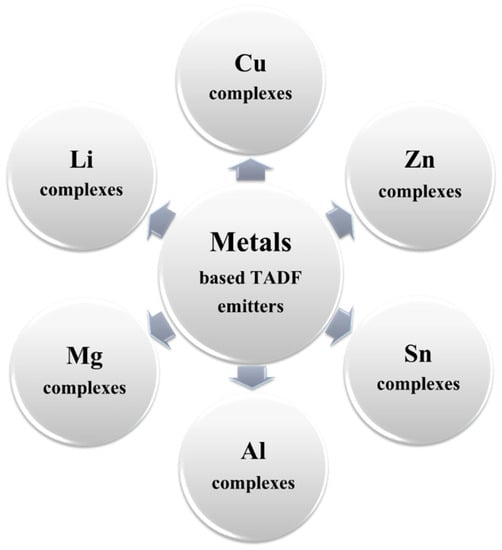
Figure 26.
Types of non-precious metal-based TADF blue emitters.
Cu Complexes
Copper (Cu) is one of the highly abundant coinage metals which has been investigated in the design of high-electroluminescence (EL) active complexes for low-cost OLEDs. In order to realize a sustainable way out, Ma et al. designed and synthesized the first Cu complex-based emitter in 1999 [196][197][298,299]. Later, many Cu complex-based phosphorescent emitters were reported because of their ability to realize a high rate of intersystem crossing (ISC) (S1→T1) and triplet radiative decay (T1→S0) [180][198][282,300].
Due to a small ΔEST, a few Cu complexes showed effective RISC (T1→S1) and singlet radiative decay (S1→S0) rates [192][199][294,301]. These complexes exhibited a small ΔEST and a fast RISC because of low-lying metal-ligand charge transfer (MLCT) excited states, which played a crucial role in realizing an effective triplet up-conversion [189][190][191][192][193][194][195][291,292,293,294,295,296,297].
Over the past few years, several Cu-based TADF emitters have been utilized in OLEDs [200][201][202][203][204][205][206][207][208][302,303,304,305,306,307,308,309,310]. Among them, only a few emitters demonstrated a blue emission. In 2011, Yersin et al. designed and synthesized a series of Cu (I) complexes (Cu-4 to Cu-6) (Figure 27) [196][298]. The ΔEST and PLQY of these compounds ranged from 0.09 to 0.16 eV and 45 to 90%, respectively, in solid state films. The chromaticity coordinates of the Cu-4 to Cu-6 emitters ranged from (0.14, 0.11) to (0.16, 0.22). In the same year, Leitl et al. reported a design strategy to realize a strong TADF emission in another Cu complex [209][311]. They observed that a small ΔEST value can be obtained by selecting heteroleptic ligands with a low torsion angle. A Cu complex (Cu-7) with two N-heterocyclic ligands, 1,3-bis(2,6-diisopropylphenyl)imidazol-2-ylidene and di(2-pyridyl)dimethylborate), showed a blue emission peaking at 475 nm. The Cu-7 exhibited a solid state PLQY of 70% and a ΔEST of 0.09 eV, resulting in a TADF decay fraction of 62% with a weak phosphorescence decay fraction of 38% [209][311].

Figure 27.
Molecular structures of copper (Cu)-based blue emitters.
In 2013, Chen et al. reported a series of Cu complex (Cu-1 to Cu-3) (Figure 27)-based emitters [210][312]. These complexes showed a constant ΔEST of 0.17 ± 0.01 eV with a PLQY ranging from 56 to 87%. Via wet-processing, the resultant maximum EQE ranged from 8.5 to 1.5%, with chromaticity coordinates ranging from greenish-blue (0.24, 0.36) to sky-blue (0.20, 0.30) as a 20 wt% of the emitters was doped into a hole-transporting host 26mCPy. The Cu-3 complex-based device also exhibited a maximum current efficiency of 24 cd/A.
In 2014, Yersin et al. reported a series of Cu complex-based emitters. Their structures were similar to the phosphorescent emitters reported earlier [209][211][311,313].
In 2015, Kang et al. reported a series of binuclear Cu halide complexes (Cu-8–Cu-10) (Figure 27) with different halogen molecules (Cl, Br, and I) [189][291]. These complexes exhibited a ΔEST value from 0.05 to 0.04 eV, a PLQY from 42 to 95%, and a decay time ranging from 4.9 to 5.9 μs with an emission wavelength ranging from blue (482 nm) to greenish blue (490 nm).
Zn Complexes
Over the past few years, several Zn complexes have been employed as EL-active emitters, hosts, and electron transporting materials in OLEDs [129][212][213][214][215][216][217][218][219][220][235,314,315,316,317,318,319,320,321,322]. However, Zn complexes exhibited a poorer device performance than that of Cu complex-based counterparts while displaying a higher stability against atmospheric moisture and air. Therefore, numerous efforts have been devoted to design Zn complex-based TADF emitters [194][221][222][296,323,324].
In order to devise a highly stable metal complex-based emitter, in 2015, Adachi’s group reported two different Zn complexes (Zn-1 and Zn-2) (Figure 28) with blue emission [184][286]. The Zn-1 and Zn-2 complexes demonstrated a PLQY of 78 and 58% and a ΔEST of 0.06 and 0.18 eV, respectively. In addition, the Zn-1 emitter also realized a low TADF decay time of 38 μs. In an mCBP host-based doped device, the Zn-1 complex showed a maximum EQE of 20% with a greenish-blue emission.
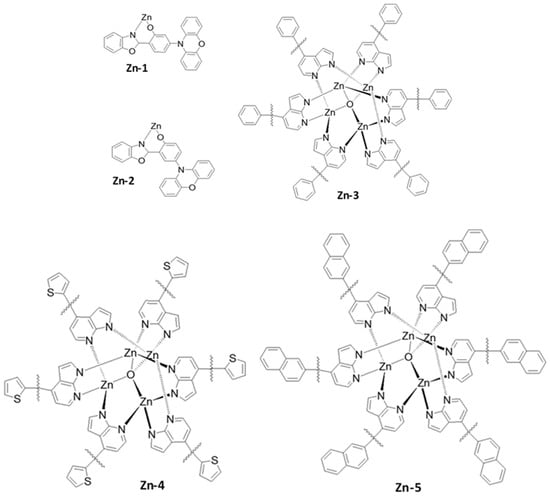
Figure 28.
Molecular structures of zinc (Zn)-based blue emitters.
Moreover, Cheng et al. designed and synthesized a series of tetranuclear zinc(II) complexes of substituted 7-azaindoles. The decay time and PLQY of these complexes ranged from 0.015 to 0.008 μs and 96 to 71%, respectively, as a 5 wt% emitter was doped into a PMMA host. The PLQY values of these compounds were measured in solid state film. The resultant maximum EQE ranged from 5.6 to 3.3%, with chromaticity coordinates ranging from (0.16, 0.19) to (0.18, 0.26) as an 8 wt% of the emitters was doped into a mixture of PVK and OXD-7 hosts [223][325].
Other Metal Complexes
In 2015, Adachi et al. studied other metal (Li, Mg, Al, and Sn) complexes for OLED device applications [184][286]. The lithium (Li) complex-based TADF emitter (Li-1) exhibited a ΔEST of 0.08 eV with a total PLQY of 70%. In a doped device with an mCBP host, the Li-1 (Figure 29) realized a maximum EQE of 13% with a greenish-blue emission. Moreover, a magnesium-based (Mg-1) (Figure 29) complex achieved a ΔEST of 0.08 eV and a PLQY of 71%, including a 58% delayed quantum yield. In a device doped with an mCBP host, the Mg-1 complex-based device exhibited a maximum EQE of 17% for a greenish-blue emission.
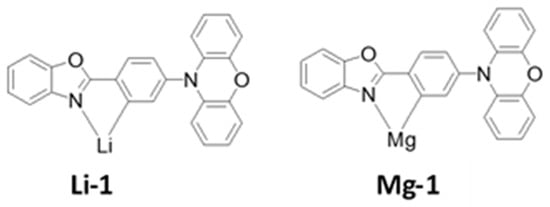
Figure 29.
Molecular structures of Lithium (Li) and Magnesium (Mg)-based blue emitters.
